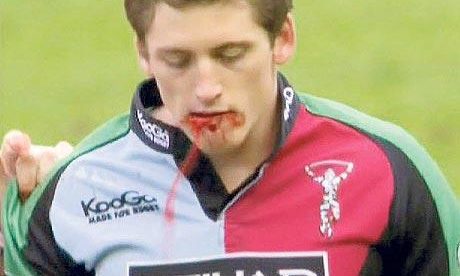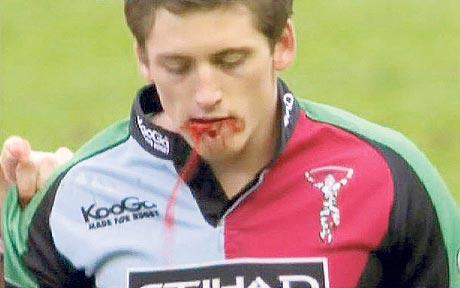The Blood*, Sweat, and Tears of English Rugby Players

Every year, twenty of the top rugby union teams from England, France, Ireland, Wales, Scotland, and Italy gather in a tournament known as the European Rugby Champions Cup. In 2017-2018, the competition hosted more than 1 million fans attending a total of 67 games with the final, Leinster Rugby of Ireland triumphing over the suburbian Parisian club of Racing 92, drawing more than 50,000 spectators. The Cup, which typically runs October through May, is almost certainly the sport’s most prominent event in the region. To win the Cup is a crowning achievement for any rugby coach.
Which is probably why the scandal now known as Bloodgate happened.
Leinster’s triumph this past May was its fourth such title, tying the record. Their first victory came in 2008-2009 when the tournament, then called the Heineken Cup, had 24 participants. The team from Ireland advanced to the knockout round after winning their pool and faced probably their biggest challenge of the tournament in the quarterfinals. In that first knockout match, Leinster faced the Harlequins, an English team based in London, and Leinster won 6-5. In the final minutes, though, the Quins (as the English team is often called) made a last-ditch effort to win. Nick Evans, probably the team’s best goal kicker, attempted what’s known as a “drop goal” with a minute left in the game. He missed, and Leinster won.
(For those who don’t know how rugby works, a drop goal is like a field goal in American football, except that the kicker punts the ball instead of doing it placekick style and not from a dead stop. Oh, and the uprights are much more narrow. The previous link goes to the Wikipedia entry for drop goals in case you want more info, and serendipitously, the image used is one of Nick Evans attempting one as a member of the Quins.)
In and of itself, the story above doesn’t even approach being a scandal. The Quins were down one, a successful drop goal would put them up two, and they had one of their top guys take the shot. If anything, that sounds like a good plan if not an obvious one. But there was a problem — Evans shouldn’t have been on the field.
At the 47-minute mark, Evans left the pitch after suffering a knee injury; teammate Chris Malone entered the game on his behalf. Typically, players who are substituted out of games may not re-enter the game. But there’s an exception made if another player starts bleeding. In that case, the bleeding player can be temporarily replaced by anyone on the bench — even previously removed players — until the bleeding stops. And with a bit more than five minutes left in the match, this is what Harlequins wing Tom Williams looked like. (Caution: it’s gross.)

That’s a lot of blood. Williams, by rule, needed to come off the pitch to be attended by doctors on the sideline. This stroke of seemingly bad luck, though, was an opportunity. The Harlequin coach, Dean Richards, was able to bring Evans back in the game at a crucial moment. It was fortuitous — almost too good to be true.
And people started to wonder: maybe it was.
As Williams left for the sideline, the TV camera noticed something weird — he was “winking toward the dugout,” as the Guardian later reported. The amount of blood coming out of his mouth was suspicious as well — that really is a lot of blood! — especially because Williams didn’t seem to fall or otherwise hit himself. Even though the Harlequins lost the match, the rugby world was abuzz with conspiracy theories. A four-month investigation followed and it turns out, in this case, the conspiracy theories were right. The blood was fake.
Before the match, the investigation concluded, Williams had been outfitted with a capsule of prop blood by the team’s physiotherapist. When directed by the coach, he bit into the capsule, causing the faux blood to flow out of his mouth — a ploy designed to allow for this otherwise-illegal substitution. Williams’ wink and the inordinate amount of blood caught the attention of skeptics but the team had a plan for that, too — when Williams apparently received medical treatment on the sideline, the opposite was actually taking place. TIME explained: “as suspicion surged around the conveniently timed injury even before the match against Leinster had ended, Harlequins medical staffers rushed to slice a real gash inside Williams’ mouth with a scalpel to cover their cheating.”
Enough people with knowledge of the ruse ended up coming forward and the relevant governing agencies took action. Williams was suspended for a year, a banishment which was reduced to four months after he appealed and confessed (and claimed he only did this under duress from Harlequin management). The team physiotherapist received a two-year ban. Richards, investigators learned, had run a similar scam at least four times prior; he was banned from coaching any rugby union team for three years. Beyond some fines, though, the club itself wasn’t punished — it’s not like they could be forced to forfeit a match they had lost anyway.
Bonus fact: Rugby: Real sport, fake blood, at least in the above case. Pro wrestling? It’s a fake sport but the blood, until recently, was often real. Some wrestlers would sneak a razor blade into the ring — perhaps hidden in their wrist wraps — and a few minutes into the match, discreetly make shallow cuts in their forehead. Due to the large number of blood vessels in the area and the amount of sweat likely already pouring down the wrestler’s face, it looked like the performer had taken quite a hefty blow. The practice, known as “blading,” was so common that foreheads of wrestlers of the era (here’s a Google image search) often show odd wrinkle-like scars. Not so much anymore though; blading fell into disuse as the risk of contracting HIV became better understood, but it wasn’t banned by the WWE until 2008.
From the Archives: “We Won’t Give Up Until You Bleed”: How Sweden collects blood, with a mix of persistence, technology, and gratitude.
